14 trail knee pads in direct comparison – Which knee pads strike the optimal balance between protection, comfort and ventilation?
When was the last time you hit the trails without knee pads? If you ask us, we hardly ever leave the house with bare knees – and we strongly hope you do the same! We put 14 lightweight knee pads through the wringer to tell you how they differ from each other, and which model offers the best balance of comfort and protection.
- This is what knee pads are all about
- How we tested
- The test field
- Tops and flops of our test
- Best in Test and Best Buy

Alongside helmets, knee pads have become an integral part of many riders’ equipment. The market for knee pads is huge and includes everything from slim and super-light models to bulky, heavy-duty protectors. However, most riders tend to roam on their home trails and negotiate climbs under their own steam. For this type of rider, a comfortable lightweight knee pad is the optimal choice – and yet a high level of protection is paramount!
We put 14 lightweight knee pads through the wringer, both in a high-tech laboratory and on various trails around the globe. All models in this test feature either a polyurethane or viscoelastic foam protector. These materials have become increasingly popular over the past few years, because they offer better protection and absorb impact forces more efficiently than conventional hard-shell models. Moreover, the malleable materials ensure a higher level of comfort and can take multiple hits, returning to their original shape after an impact and thus continuing to offer reliable protection.
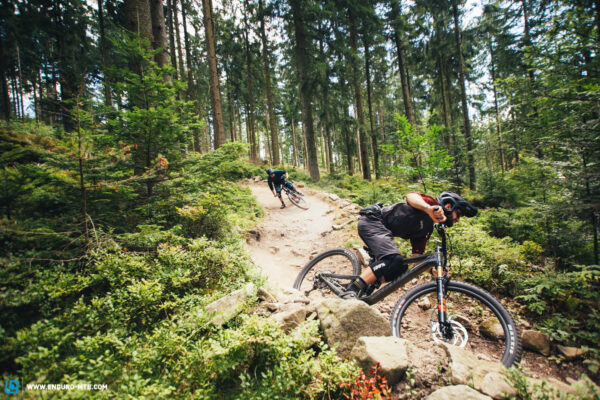
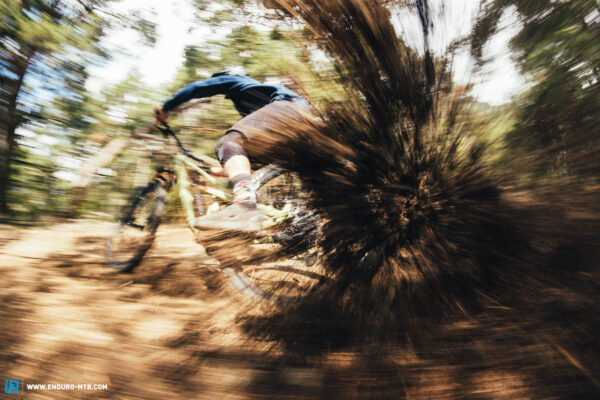
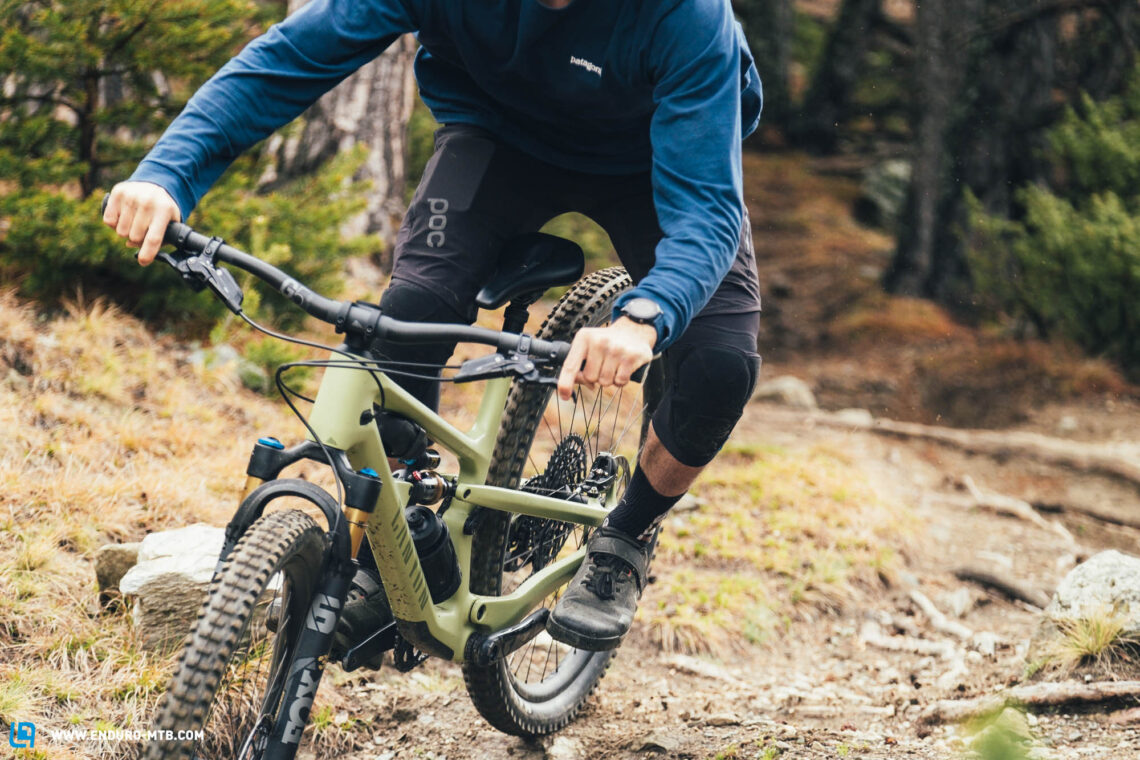
This is what knee pads are all about
There are more knee pads on the market than stars in the firmament and yet only the best models manage to strike the optimal balance between protection and ventilation while at the same time ensuring a high level of comfort. Needless to say, manufacturing quality and look also play a crucial role.
Is beefier always better? Protection first!
First and foremost, all knee pads in this test meet the EN 1621-1:2012 Standard for motorcycle limb joint impact protection, thus offering a high level of protection. However, there are still differences within the same standard – it includes two different protection levels, which indicate how much residual force may reach the knee with a given impact. Another crucial factor is the size of the protector and the extent to which this encloses the knee to protect it against lateral impacts. Here, protection isn’t just about size and beefiness, but also about the quality of the material of the protector and the fit – a knee pad can only offer a good level of protection if it doesn’t slip during a crash. Some models also have additional layers of simple PU foam sewn into the side, but these don’t add much to the protective qualities of the knee pad.
Comfort is paramount
Comfort should be high on your priority list when choosing a knee pad, especially if you’re planning to spend long days in the saddle. A slight pressure on the shin, a pinch at the back of the knee or light rubbing sensation on the calf might not a be that big of a deal on a short post-work ride, but could potentially transform a fun day out in the mountains into a real suffer fest if you spend many hours pedalling with the knee pads on – especially when you’re on a four-day backcountry expedition with your mates and can already feel the pads chafing your legs after the first few kilometres…
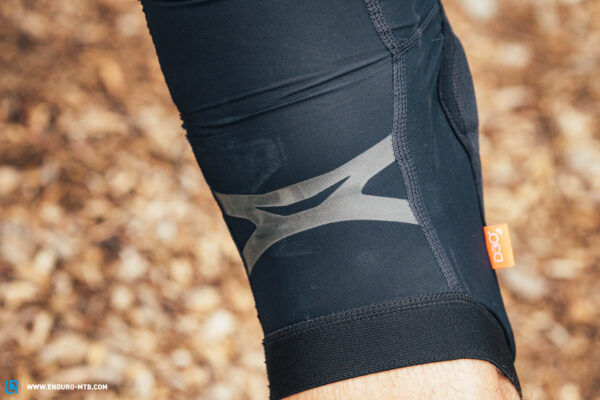
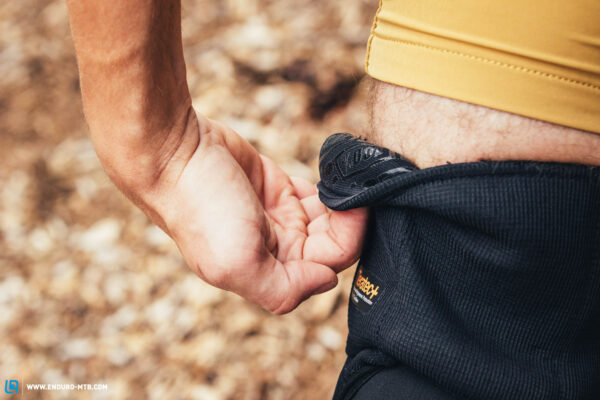
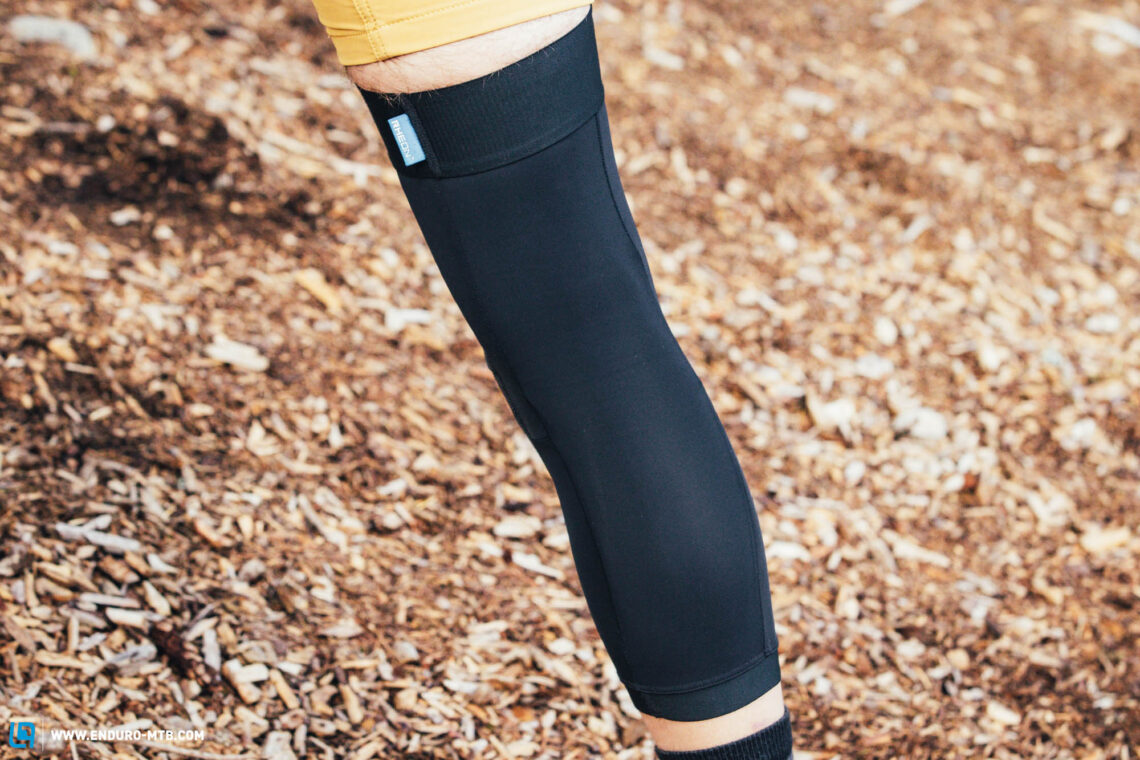
Only a protector that fits well offers protection
With all things protection, a good fit is essential – and knee pads are no exception. Having to pull up a slipping knee pad every two minutes is a real pain and if the pad doesn’t sit where you need it during a crash, shit quickly hits the fan. Needless to say, knee pads should fit well with both short and long trousers. The manufacturers in this test use a few different approaches to make sure their pads stay put: some use a simple slip-on, sock-like sleeve while others rely on a Velcro fastener to secure the pad to the thigh, calf or the back of the knee. Most models feature a rubber or silicone strip on the thigh or calf to prevent it from slipping. This leads to another important criterion: how easy it is to put on and take off the knee pad.
A pleasant climate is key, even on hot summer days
The level of ventilation of a knee pad depends on multiple factors, one of them being the type and thickness of the material. Another is the design of the main sleeve that holds the protector, with some manufacturers relying on an open design at the rear and others covering the hollow of the knee with a thin mesh. Most knee pads in this test rely on vent holes in the protector pad, while some also feature perforations and vents in the sleeve to help ensure a good interior climate.
Of course, manufacturing quality and looks are very important too
Last but not least, knee pads form part of your outfit and, if possible, should match the style of your riding gear. Alongside style, we also take into account other practical aspects such as packability and dimensions. Are the protectors removable or sewn into the sleeve? Moreover, different manufacturers recommend different washing programmes, which can vary greatly from knee pad to knee pad! Regardless of the manufacturer’s recommendations, we always recommend washing knee pads with integrated protectors by hand. Even if the foam or rubber protector doesn’t absorb water, it could be damaged by mechanical stress in a washing machine.
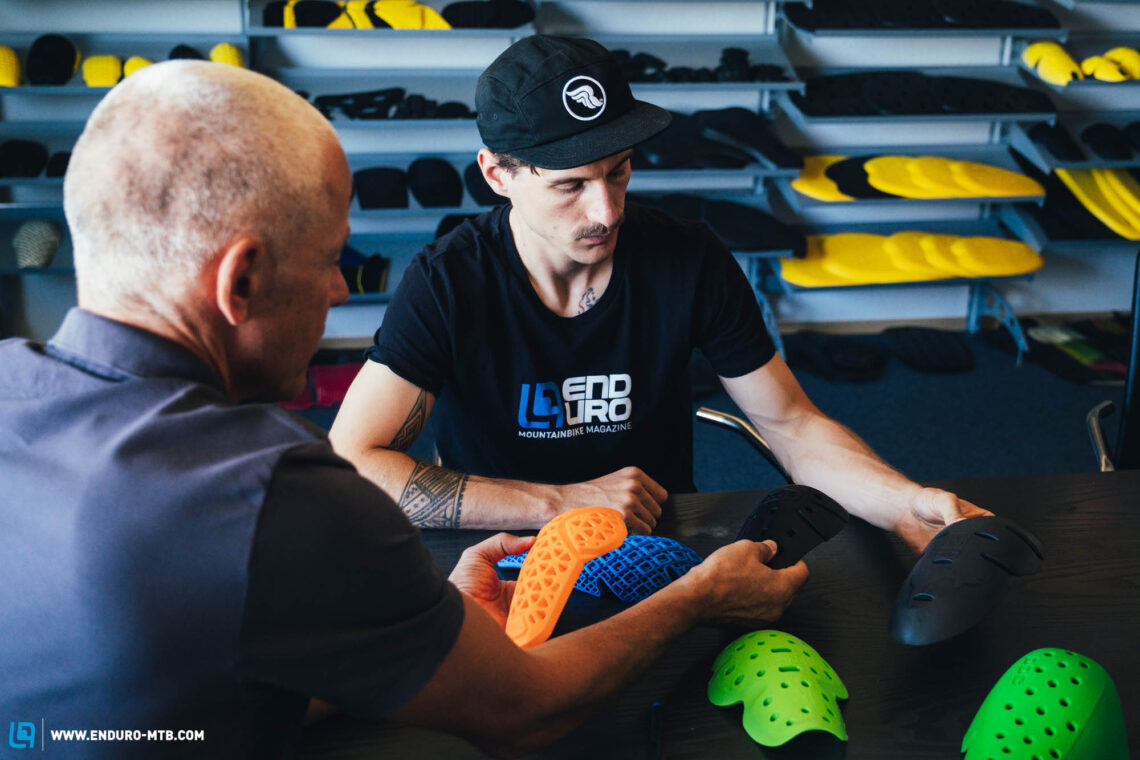
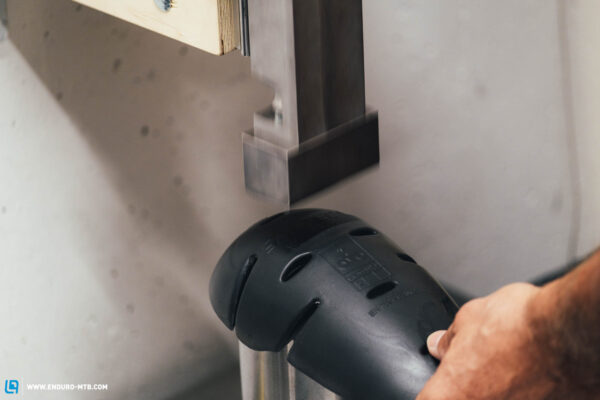
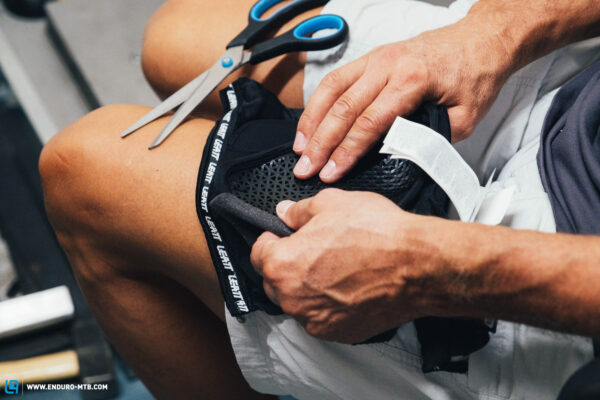
How we tested
We carried out this test in two phases; first in a laboratory, and then on the trail. We didn’t want to try our luck having lots of crashes to find out which pads work best, so In the lab, we measured the protectors’ capacity for shock absorption, while on the trail, we asked our editorial team to rate the pads for comfort, fit, ventilation and looks.
Laboratory tests based on the standard testing procedures
For the first testing phase, we teamed up with protector specialist SAS-TEC and carried out a simplified version of the CE test in their high-tech facilities to ensure that all protectors meet the EN 1621-1:2012 Standard for motorcycle limb joint impact protection. Since there is no official certification for mountain bike protectors, the EN 1621-1:2012 Standard is used as a reference. Each model was subjected to an impact with a 5 kg weight, dropped from a height of one metre. A hemispherical anvil replicates the knee joint while a number of sensors measure the residual force and draw a force curve. Without a protector, the impact force on the anvil reads around 180 kN, which corresponds to +/- 18 tonnes. With protection Level 1, the average residual force distributed over 9 measuring points must not exceed 35 kN. With Level 2 the average residual force must remain below 20 kN.
With each protector, we measured the average residual force in three different points, once with the fabric sleeve and once without. As already mentioned, all contestants in this comparison test successfully cleared Level 1, with some models even passing the stricter Level 2 requirements – however, the latter are also a little beefier and heavier than their Level 1 counterparts. This means that all protectors in this test reduce the force acting on the knees by at least 80%.
“Flatten the curve” knee pad edition!
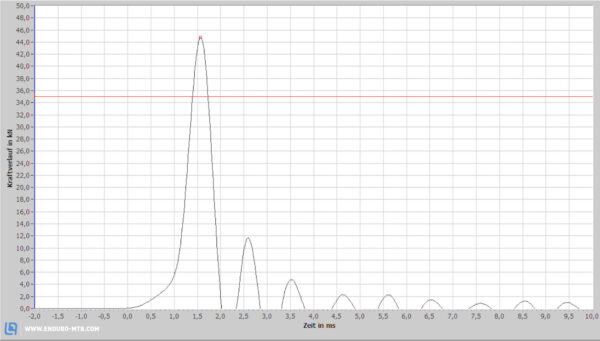
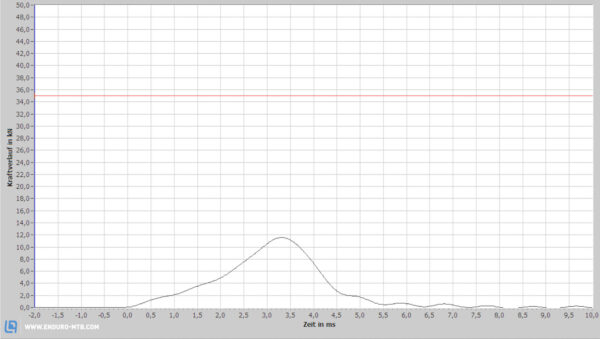
Above are two examples of force curves. The diagram to the left shows the average residual force of a protector that isn’t included in this test while the graph to the right belongs to one of the tested models – and that’s a good curve! The two decisive values in the graph are the maximum force and the time at which this occurs. The linear and, above all, moderate increase of the right-hand curve means that the applied forces don’t act suddenly and abruptly, but rather moderately and gently as they are mostly absorbed by the protector, which means that the body can still tolerate them. With slower forces (we’re still talking about milliseconds though!), the body tissue can still deform and the leg moves to the side. In addition, the maximum force applied is around 11 kN, which is well below the specified limits. Compare this with the left graph, where the force curve steepens suddenly, peaking at 45kN. Here, the body tissues and bones take the brunt of the impact, which far exceeds the levels permitted by the test standard.
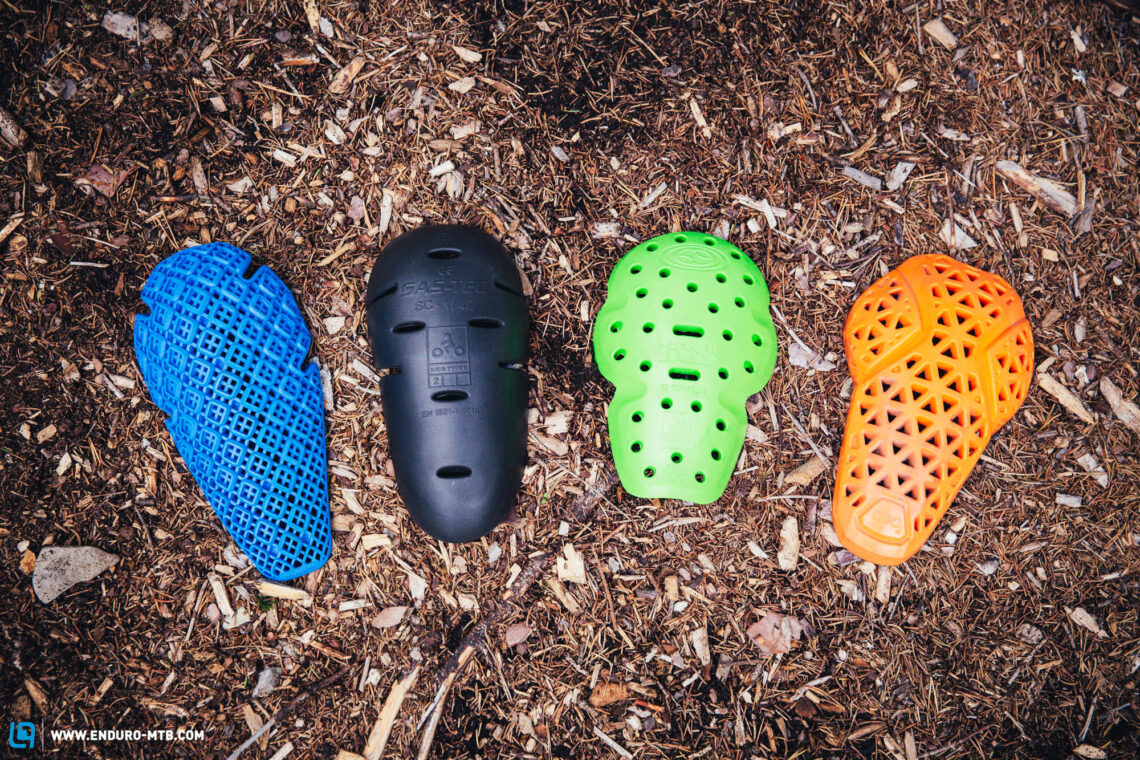
Practical test on the trails
The practical tests were carried out by our editorial team, who wore the knee pads on countless post-work rides, epic backcountry expeditions and bike park weekends in all possible conditions. Given the different anatomical proportions of our test riders and the different scenarios in which we tested, we were able to get a good overall picture of which protectors are ENDURO-approved and which ones aren’t.
The test field
Our test field consists of 14 knee pads from the most popular brands. Although all models employ similar or, in some cases, even identical protectors, the pads differ significantly in comfort, weight, style and protection.
The lab test results show an average of three readings, one taken at the centre of the kneecap, one below the kneecap, and one side impact. For each pad, you will see the maximum residual force recorded, and the time from impact it was recorded. A pad with a low maximum residual force and long delay should provide better protection than one which delivers a higher amount of force in a shorter time. The weight refers to the size M of each model.
| Knee pad | Weight | Price | Certification | Removable Protector | Fastening System | Lab-test Results |
|---|---|---|---|---|---|---|
| 100% Teratec Plus (Click for review) |
210 g | € 79.00 | Level 1 | No | Elastic band | 20 kN at 2.4 ms |
| Alpinestars Paragon Plus (Click for review) |
173 g | € 59.99 | Level 1 | No | Elastic band | 14 kN at 3.3 ms |
| AMPLIFI Havok (Click for review) |
213 g | € 119.99 | Level 2 | No | Velcro fastener top side | 11 kN at 3.8 ms |
| Chromag Rift Knee Guard (Click for review) |
147 g | € 101.95 | Level 1 | No | Elastic band | 19 kN at 3.0 ms |
| Fox Launch D3O (Click for review) |
207 g | € 84.99 | Level 1 | No | Velcro fastener top and bottom | 19 kN at 2.7 ms |
| Ion K Lite (Click for review) |
168 g | € 99.99 | Level 1 | Yes | Velcro fastener at the back of the knee | 21 kN at 3.0 ms |
| iXS FLOW EVO+ (Click for review) |
143 g | € 89.90 | Level 1 | Yes | Velcro fastener at the back of the knee | 20 kN at 3.6 ms |
| Leatt AirFlex Pro (Click for review) |
126 g | € 89.99 | Level 1 | No | Elastic band | 22 kN at 1.6 ms |
| Ortema GP5 Knee Protector (Click for review) |
136 g | € 89.00 | Level 2 | Yes | Elastic band | 13 kN at 3.4 ms |
| Pearl Izumi Elevate Knee Guard V1 (Click for review) |
174 g | € 129.95 | Level 1 | Yes | Velcro fastener at the back of the knee | 21 kN at 2.7 ms |
| POC Joint VPD 2.0 Knee (Click for review) |
329 g | € 160.00 | Level 2 | No | Velcro fastener top side and at the back of the knee | 8 kN at 2.7 ms |
| Rapha Trail Knee Pad (Click for review) |
182 g | € 95.00 | Level 2 | Yes | Elastic band | 14 kN at 2.1 ms |
| SCOTT Soldier 2 (Click for review) |
181 g | € 79.95 | Level 1 | Yes | Elastic band | 18 kN at 3.0 ms |
| Troy Lee Designs Stage (Click for review) |
154 g | € 90.00 | Level 1 | No | Elastic band | 20 kN at 2.8 ms |

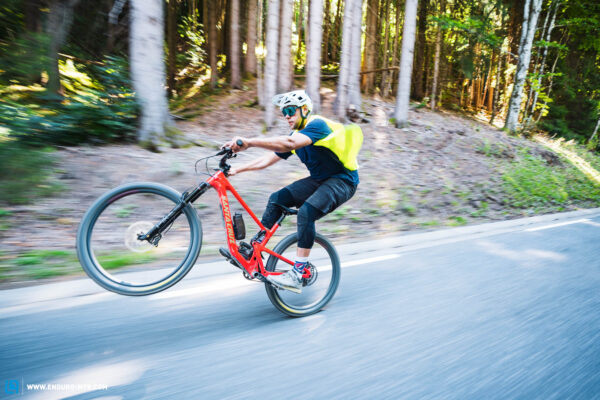
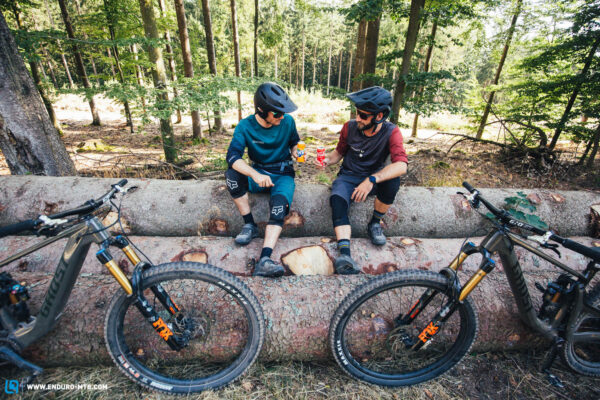
Tops
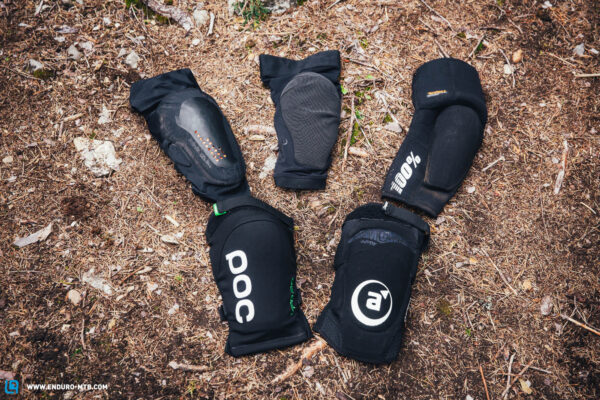
In the lab tests, all protectors proved that they offer a good level of protection.
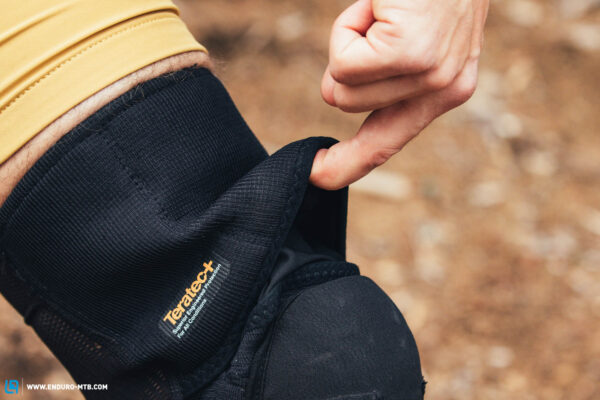
Thanks to the flexible fabric between the cuff and protector, the 100% Teratec Plus offers a high level of comfort when pedalling.
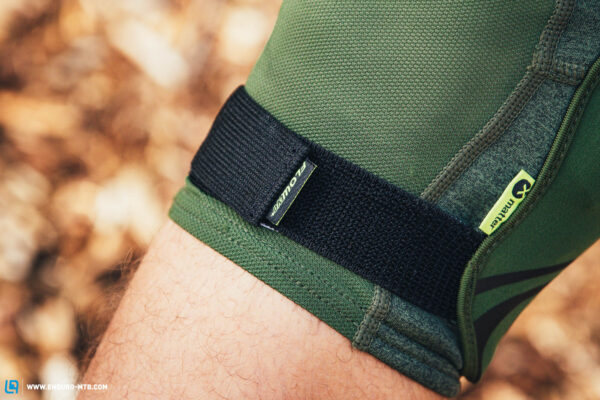
The Velcro strap in the hollow of the knee of the iXS Flow Evo+ can be secured over its entire length, thus allowing for individual size adjustments.
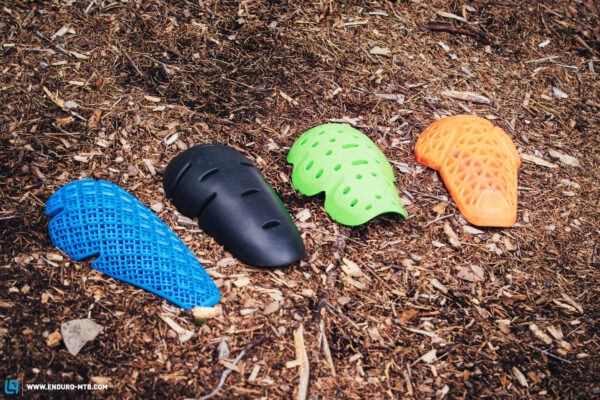
Many knee pads in this test come with holes in the protector, which ensures a pleasant climate in combination with a suitable fabric.
Flops

Knee-noooo, knee-noooo… the fashion police is on its way! Small openings revealing bare skin are not a great look – the Fox and Leatt ended up behind bars!

While the straps at the back of the knees seem a sensible idea, with the Pearl Izumi, POC and ION knee pads they don’t do the fit any favours and even rub against the trousers in places.
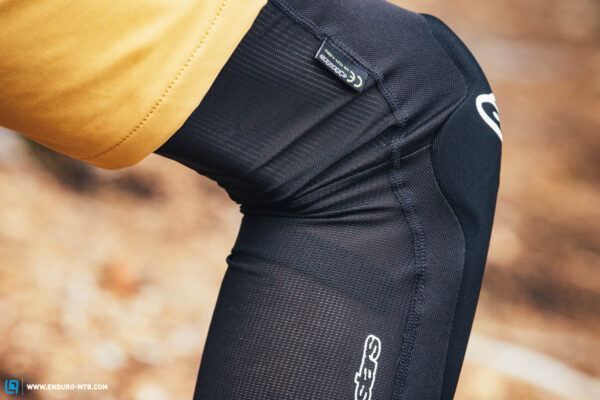
… is what you get with the iXS and Alpinestars. Although this isn’t too much of an issue at first, it really limits the riding comfort in the long run.
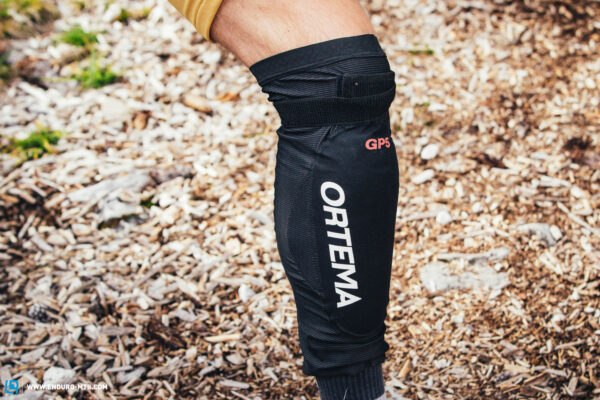
Only a protector that fits well can offer a high level of protection. However, models such as the Ortema and AMPLIFI slip noticeably, failing to provide sufficient protection.
Best in Test and Best Buy
The test field of our 2022 knee pad comparison test is big and all protectors have their pros and cons – you’ll find all of them in their respective reviews. The one protector that manages to combine the most important qualities, sometimes even merging supposedly antithetical properties, is the Rapha Trail Knee Pad. Despite renouncing a Velcro strap, it fits like a glove and is incredibly comfortable even after a long day in the saddle. As if that wasn’t good enough, it employs one of the best-performing protectors in the entire test field – a well-deserved Best in Test!
A knee pad that fits like no other in this test field is the 100% Teratec Plus. Thanks to its wide cuff on the thigh, it doesn’t budge a millimetre even in the roughest trail sections. In addition, we found it to be the most comfortable model for pedalling missions. Our undisputed Best Buy Tip!
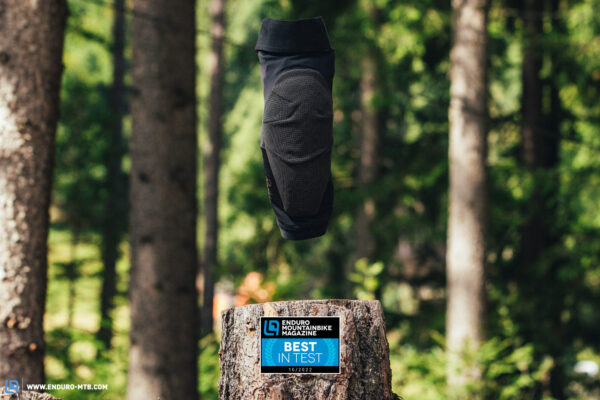
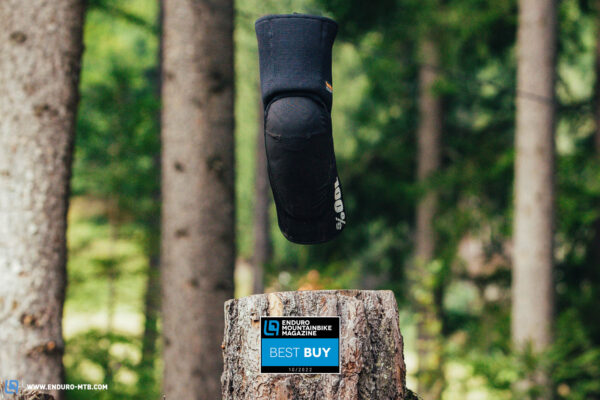
Conclusion
Good news from our knee pad group test: all models in this test offer a good level of protection! Moreover, they all employ a soft protector that ensures a high level of comfort and excellent shock absorption. In terms of ventilation and fit, however, there are some major differences between the models. However, the choice of knee pads strongly depends on your anatomy and your needs and preferences; because the best knee pads are always the ones you actually wear.
All kneepads in test: 100% Teratec Plus (Click for review) | Alpinestars Paragon Plus (Click for review) | AMPLIFI Havok (Click for review) | Chromag Rift Knee Guard (Click for review) | Fox Launch D3O (Click for review) | Ion K Lite (Click for review) | iXS FLOW EVO+ (Click for review) | Leatt AirFlex Pro (Click for review) | Ortema GP5 Knee Protector (Click for review) | Pearl Izumi Elevate Knee Guard V1 (Click for review) | POC Joint VPD 2.0 Knee (Click for review) | Rapha Trail Knee Pad (Click for review) | Scott Soldier 2 (Click for review) | Troy Lee Designs Stage (Click for review)
